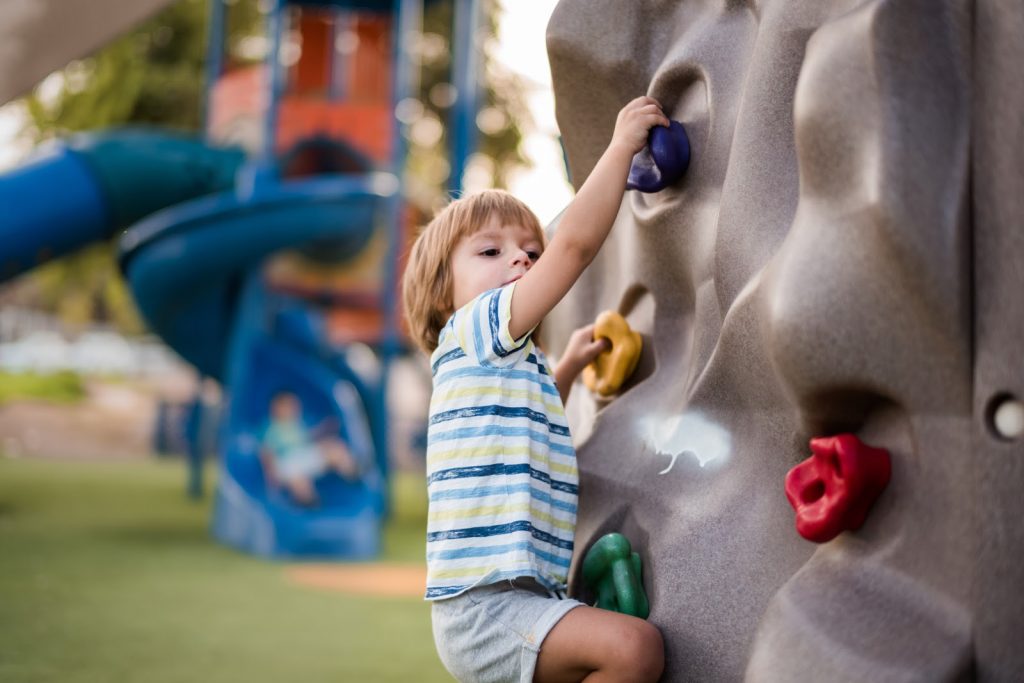
Play is one of the most powerful learning tools children have, but the possibilities it opens up are truly endless. A single activity, like scaling a plastic climber on the playground, can have several different benefits, contributing to both a healthier body and a happier mind. Read on to learn about eight ways that climbing can help kids of all ages achieve their full potential.
1. Increase Flexibility & Strength
When kids are exploring plastic climbers, they’re using almost every muscle in their body. Their legs, arms, and core muscles all get a workout, and to reach the next handhold, they might have to stretch farther than they knew they could. The different paths available to climb means that a child’s muscles get worked in different ways, especially if different playground components work together to create unique routes for kids to explore.
2. Improve Endurance
Endurance doesn’t just refer to physical ability, although that certainly plays a factor. When children are presented with the challenge of a plastic climber, they’re also presented with the opportunity to keep trying, even if the solution doesn’t come easily at first. Sometimes, a handhold might be too far away from their current position. That means they can either give up – or they can climb down and try another way. Perseverance is a lifelong skill, and plastic climbers mean that kids can begin practicing early.
3. Better Hand & Foot Coordination
Hand and foot coordination is one of the most basic skills that young children develop. With greater control and dexterity, they discover new talents and abilities. Plastic climbers usually have foot and handholds that are shaped differently than what a child may have encountered before. As these connecting points are the only way to progress up the wall, a child will have to practice precise limb movement.
Climbing the wall will get easier, but the benefits extend well outside the playground, too. Children who develop motor skills more quickly will find it easier to become independent, practice writing, and enjoy more creative freedom.
4. Build Confidence
To a small child, a plastic climber might seem pretty intimidating at first glance. However, with that first attempt at climbing will come the development of better confidence and, as they improve, a healthy measure of self-esteem. Making the choice to attempt something that seems scary is something that even adults struggle with, and plastic climbers introduce children to this concept in a safe and gentle way.
5. Develop Problem-Solving Skills
Pretend you’re a small child, and you’re halfway up the climbing wall. Trouble is, the blue handhold that you want to grab next is too far away. What do you do now?
The act of climbing forces children to make many decisions, right after one another. Do they go up? Do they climb back down? Do they feel secure enough to reach for a different handhold than the one they originally wanted? Initially, a child may stick with making decisions as they go, but as they become more experienced, they’ll have a better idea of what they can do. When they reach this stage, they may start planning their movements before they even set foot on the climbing wall. Problem-solving and planning ahead, as with motor control, will be skills they’ll use for the rest of their life.
6. Relieve Stress
It’s easy to fixate and worry about things, even for young minds. Not getting the snack they wanted at lunch can be a cloud that hovers over them for the rest of the day. Plastic climbers effectively help kids relieve stress in two different ways.
First, they’re physical in nature, and numerous studies have shown that physical exercise can help alleviate stress. Secondly, and perhaps most importantly, plastic climbers require a child’s full attention. Children must fully exist in the present moment as they navigate their way up the wall. When they reach the top, they may have entirely forgotten what they were upset or worried about when they began.
7. Develop Safe Risk Assessment
When we’re young, we think we can literally do anything: flying in the clouds or jumping over the moon isn’t a question of if, but when. When children decide to test these limits all at once, it can be dangerous.
Plastic climbers offer children a safe environment to learn to evaluate risk. If a child tries to jump from one handhold to another and misses, they’ll fall – but they’ll land on soft playground sand or mulch. Instead of running away with a sore bottom, they can stand up, brush themselves off, and try again. They’ll learn what they can do, and what they need to work up to, and as their boundaries grow, so will their appetite for safe adventures.
8. Better Academic Performance
As children continue to play and exercise outside, they’re also giving themselves a helping hand academically. Studies have suggested that active outdoor play and problem-solving activities, like climbing, help children perform better on academic assessments and improve their ability to learn. Plastic climbers offer a unique opportunity for children to improve both their bodies and their minds at the same time, making them a valuable component of any playground.
At SPI Plastics, we specialize in both indoor and outdoor playground components. Give us a call at (519) 935-2211 for more information on our products, including plastic climbers. You can also send us a message online to learn more about the custom design work we perform as a plastic manufacturer.